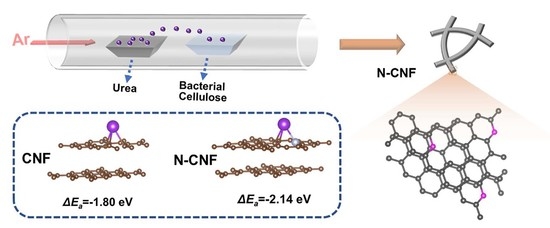Ultra-Stable Potassium Ion Storage of Nitrogen-Doped Carbon Nanofiber Derived from Bacterial Cellulose
Abstract
1. Introduction
2. Experimental
2.1. Synthesis
2.2. Characterization
2.3. Computational Methods
2.4. Electrochemical Measurement
3. Results and Discussion
4. Conclusions
Supplementary Materials
Author Contributions
Funding
Conflicts of Interest
References
- Cheng, J.; Gao, L.; Li, T.; Mei, S.; Wang, C.; Wen, B.; Huang, W.; Li, C.; Zheng, G.; Wang, H.; et al. Two-Dimensional Black Phosphorus Nanomaterials: Emerging Advances in Electrochemical Energy Storage Science. Nano-Micro Lett. 2020, 12, 1–34. [Google Scholar] [CrossRef]
- Xie, J.; Lu, Y.-C. A retrospective on lithium-ion batteries. Nat. Commun. 2020, 11, 1–4. [Google Scholar] [CrossRef]
- Liu, B.; Jia, Y.; Yuan, C.; Wang, L.; Gao, X.; Yin, S.; Xu, J. Safety issues and mechanisms of lithium-ion battery cell upon mechanical abusive loading: A review. Energy Storage Mater. 2020, 24, 85–112. [Google Scholar] [CrossRef]
- Li, L.; Zhao, R.; Xu, T.; Wang, D.; Pan, D.; Zhang, K.; Yu, C.; Lu, X.; He, G.; Bai, Y. Stabilizing a high-voltage LiNi0.5Mn1.5O4 cathode towards all solid state batteries: A Li–Al–Ti–P–O solid electrolyte nano-shell with a host material. Nanoscale 2019, 11, 8967–8977. [Google Scholar] [CrossRef]
- Zhou, N.F.; Qin, W.; Wu, C.; Jia, C.K. Graphene-attached vanadium sulfide composite prepared via microwave-assisted hydro-thermal method for high performance lithium ion batteries. J. Alloys Compd. 2020, 834, 155073. [Google Scholar] [CrossRef]
- Xie, J.; Zhu, Y.; Zhuang, N.; Li, X.; Yuan, X.; Li, J.; Hong, G.; Mai, W. High-concentration ether-based electrolyte boosts the electrochemical performance of SnS2–reduced graphene oxide for K-ion batteries. J. Mater. Chem. A 2019, 7, 19332–19341. [Google Scholar] [CrossRef]
- Zu, L.; Zhang, W.; Qu, L.; Liu, L.; Li, W.; Yu, A.; Zhao, D. Mesoporous Materials for Electrochemical Energy Storage and Conversion. Adv. Energy Mater. 2020, 10, 2002152. [Google Scholar] [CrossRef]
- Li, J.L.; Zhuang, N.; Xie, J.P.; Li, X.D.; Zhuo, W.C.; Wang, H.; Na, J.B.; Li, X.B.; Yamauchi, Y.; Mai, W.J. K-ion storage enhancement in Sb2O3/reduced graphene oxide using ether-based electrolyte. Adv. Energy Mater. 2020, 10, 1903455. [Google Scholar] [CrossRef]
- Rajagopalan, R.; Tang, Y.G.; Ji, X.B.; Jia, C.K.; Wang, H.Y. Advancements and challenges in potassium ion batteries: A comprehen-sive review. Adv. Funct. Mater. 2020, 30, 1909486. [Google Scholar] [CrossRef]
- Li, X.; Li, J.; Ma, L.; Yu, C.; Ji, Z.; Pan, L.; Mai, W. Graphite Anode for Potassium ion batteries: Current Status and Perspective. Energy Environ. Mater. 2021. [Google Scholar] [CrossRef]
- Zhang, E.J.; Jia, X.N.; Wang, B.; Wang, J.; Yu, X.Z.; Lu, B.G. Carbon dots@rGO paper as freestanding and flexible potassium-ion batteries anode. Adv. Sci. 2020, 7, 2000470. [Google Scholar] [CrossRef]
- Cheng, X.L.; Li, D.J.; Wu, Y.; Xu, R.; Yu, Y. Bismuth nanospheres embedded in three-dimensional (3D) porous graphene frame-works as high performance anodes for sodium- and potassium-ion batteries. J. Mater. Chem. A 2019, 7, 4913–4921. [Google Scholar] [CrossRef]
- Zhu, H.; Liu, T.; Peng, L.; Yao, W.; Kang, F.; Shu, J.; Yang, C. A compact Bi2WO6 microflowers anode for potassium-ion storage: Taming a sequential phase evolution toward stable electrochemical cycling. Nano Energy 2021, 82, 105784. [Google Scholar] [CrossRef]
- Xie, J.; Li, X.; Lai, H.; Zhao, Z.; Li, J.; Zhang, W.; Xie, W.; Liu, Y.; Mai, W. A Robust Solid Electrolyte Interphase Layer Augments the Ion Storage Capacity of Bimetallic-Sulfide-Containing Potassium-Ion Batteries. Angew. Chem. Int. Ed. 2019, 58, 14740–14747. [Google Scholar] [CrossRef]
- Li, J.; Qin, W.; Xie, J.; Lei, H.; Zhu, Y.; Huang, W.; Xu, X.; Zhao, Z.; Mai, W. Sulphur-doped reduced graphene oxide sponges as high-performance free-standing anodes for K-ion storage. Nano Energy 2018, 53, 415–424. [Google Scholar] [CrossRef]
- Wu, X.; Chen, Y.L.; Xing, Z.; Lam, C.W.K.; Pang, S.S.; Zhang, W.; Ju, Z.C. Advanced carbon-based anodes for potassium-ion bat-teries. Adv Energy Mater. 2019, 9, 1900343. [Google Scholar] [CrossRef]
- Cui, R.C.; Xu, B.; Dong, H.J.; Yang, C.C.; Jiang, Q. N/O Dual-doped environment-friendly hard carbon as advanced anode for potassium-ion batteries. Adv. Sci. 2020, 7, 1902547. [Google Scholar] [CrossRef] [PubMed]
- Fan, L.; Ma, R.; Zhang, Q.; Jia, X.; Lu, B. Graphite Anode for a Potassium-Ion Battery with Unprecedented Performance. Angew. Chem. Int. Ed. 2019, 58, 10500–10505. [Google Scholar] [CrossRef]
- Luo, W.; Wan, J.; Ozdemir, B.; Bao, W.; Chen, Y.; Dai, J.; Lin, H.; Xu, Y.; Gu, F.; Barone, V.; et al. Potassium Ion Batteries with Graphitic Materials. Nano Lett. 2015, 15, 7671–7677. [Google Scholar] [CrossRef] [PubMed]
- Jian, Z.; Luo, W.; Ji, X. Carbon Electrodes for K-Ion Batteries. J. Am. Chem. Soc. 2015, 137, 11566–11569. [Google Scholar] [CrossRef] [PubMed]
- Li, J.; Zhuang, N.; Xie, J.; Zhu, Y.; Lai, H.; Qin, W.; Javed, M.S.; Xie, W.; Mai, W. Carboxymethyl Cellulose Binder Greatly Stabilizes Porous Hollow Carbon Submicrospheres in Capacitive K-Ion Storage. ACS Appl. Mater. Interfaces 2019, 11, 15581–15590. [Google Scholar] [CrossRef]
- Lin, X.; Huang, J.; Zhang, B. Correlation between the microstructure of carbon materials and their potassium ion storage performance. Carbon 2019, 143, 138–146. [Google Scholar] [CrossRef]
- Alvin, S.; Chandra, C.; Kim, J. Controlling intercalation sites of hard carbon for enhancing Na and K storage performance. Chem. Eng. J. 2021, 411, 128490. [Google Scholar] [CrossRef]
- Bobyleva, Z.V.; Drozhzhin, O.A.; Dosaev, K.A.; Kamiyama, A.; Ryazantsev, S.V.; Komaba, S.; Antipov, E.V. Unveiling pseudo-capacitive behavior of hard carbon anode materials for sodium-ion batteries. Electrochim. Acta 2020, 354, 136647. [Google Scholar] [CrossRef]
- Ghimbeu, C.M.; Górka, J.; Simone, V.; Simonin, L.; Martinet, S.; Vix-Guterl, C. Insights on the Na+ ion storage mechanism in hard carbon: Discrimination between the porosity, surface functional groups and defects. Nano Energy 2018, 44, 327–335. [Google Scholar] [CrossRef]
- Wu, Z.; Wang, L.; Huang, J.; Zou, J.; Chen, S.; Cheng, H.; Jiang, C.; Gao, P.; Niu, X. Loofah-derived carbon as an anode material for potassium ion and lithium ion batteries. Electrochim. Acta 2019, 306, 446–453. [Google Scholar] [CrossRef]
- Alvin, S.; Yoon, D.; Chandra, C.; Cahyadi, H.S.; Park, J.H.; Chang, W.; Chung, K.Y.; Kim, J. Revealing sodium ion storage mecha-nism in hard carbon. Carbon 2019, 145, 67–81. [Google Scholar] [CrossRef]
- Xu, B.; Qi, S.; Li, F.; Peng, X.; Cai, J.; Liang, J.; Ma, J. Cotton-derived oxygen/sulfur co-doped hard carbon as advanced anode material for potassium-ion batteries. Chin. Chem. Lett. 2020, 31, 217–222. [Google Scholar] [CrossRef]
- Vaalma, C.; Buchholz, D.; Passerini, S. Non-aqueous potassium-ion batteries: A review. Curr. Opin. Electrochem. 2018, 9, 41–48. [Google Scholar] [CrossRef]
- Song, P.; Shen, X.; He, X.; Feng, K.; Kong, L.; Ji, Z.; Zhai, L.; Zhu, G.; Zhang, D. Cellulose-derived nitrogen-doped hierarchically porous carbon for high-performance supercapacitors. Cellulose 2018, 26, 1195–1208. [Google Scholar] [CrossRef]
- Ding, C.; Liu, T.; Yan, X.; Huang, L.; Ryu, S.; Lan, J.; Yu, Y.; Zhong, W.-H.; Yang, X. An Ultra-microporous Carbon Material Boosting Integrated Capacitance for Cellulose-Based Supercapacitors. Nano-Micro Lett. 2020, 12, 1–17. [Google Scholar] [CrossRef]
- Belaustegui, Y.; Pantò, F.; Urbina, L.; Corcuera, M.A.; Eceiza, A.; Palella, A.; Triolo, C.; Santangelo, S. Bacterial-cellulose-derived carbonaceous electrode materials for water desalination via capacitive method: The crucial role of defect sites. Desalination 2020, 492, 114596. [Google Scholar] [CrossRef]
- Zhu, G.; Wang, H.; Xu, H.; Zhang, L. Enhanced capacitive deionization by nitrogen-doped porous carbon nanofiber aerogel derived from bacterial-cellulose. J. Electroanal. Chem. 2018, 822, 81–88. [Google Scholar] [CrossRef]
- Illa, M.P.; Khandelwal, M.; Sharma, C.S. Bacterial cellulose-derived carbon nanofibers as anode for lithium-ion batteries. Emer-gent Mater. 2018, 1, 105–120. [Google Scholar] [CrossRef]
- Yang, H.; Xu, R.; Yu, Y. A facile strategy toward sodium-ion batteries with ultra-long cycle life and high initial Coulombic effi-ciency: Free-standing porous carbon nanofiber film derived from bacterial cellulose. Energy Storage Mater. 2019, 22, 105–112. [Google Scholar] [CrossRef]
- Zhang, J.M.; Hua, Q.; Li, J.; Yuan, J.; Peijs, T.; Dai, Z.; Zhang, Y.; Zheng, Z.; Zheng, L.; Tang, J. Cellulose-Derived Highly Porous Three-Dimensional Activated Carbons for Supercapacitors. ACS Omega 2018, 3, 14933–14941. [Google Scholar] [CrossRef]
- Li, H.; Cheng, Z.; Zhang, Q.; Natan, A.; Yang, Y.; Cao, D.; Zhu, H. Bacterial-Derived, Compressible, and Hierarchical Porous Carbon for High-Performance Potassium-Ion Batteries. Nano Lett. 2018, 18, 7407–7413. [Google Scholar] [CrossRef]
- Hu, J.X.; Xie, Y.Y.; Yin, M.; Zhang, Z.A. Nitrogen doping and graphitization tuning coupled hard carbon for superior potassi-um-ion storage. J. Energy Chem. 2020, 49, 327–334. [Google Scholar] [CrossRef]
- Wang, G.; Yu, L.; Gao, J.; Li, Y.; Zeng, S.; Zhang, G. Dual-functional template-induced in situ polymerization process enables the hierarchical carbonaceous nanotubes with simultaneous Sn cluster incorporation and nitrogen-doping for superior potas-sium-ion storage. ACS Appl. Mater. Interfaces 2021, 13, 13139–13148. [Google Scholar]
- Xiong, P.; Zhao, X.; Xu, Y. Nitrogen-Doped Carbon Nanotubes Derived from Metal-Organic Frameworks for Potassium-Ion Battery Anodes. ChemSusChem 2018, 11, 202–208. [Google Scholar] [CrossRef]
- Li, Y.; Liu, N.; Zhang, T.; Wang, B.; Wang, Y.; Wang, L.; Wei, J. Highly microporous nitrogen-doped carbons from anthracite for effective CO2 capture and CO2/CH4 separation. Energy 2020, 211, 118561. [Google Scholar] [CrossRef]
- Zhang, S.; Xu, Z.; Duan, H.; Xu, A.; Xia, Q.; Yan, Y.; Wu, S. N-doped carbon nanofibers with internal cross-linked multiple pores for both ultra-long cycling life and high capacity in highly durable K-ion battery anodes. Electrochim. Acta 2020, 337, 135767. [Google Scholar] [CrossRef]
- Jin, Q.Z.; Wang, K.L.; Feng, P.Y.; Zhang, Z.C.; Cheng, S.J.; Jiang, K. Surface-dominated storage of heteroatoms-doping hard car-bon for sodium-ion batteries. Energy Storage Mater. 2020, 27, 43–50. [Google Scholar] [CrossRef]
- Li, X.; Liu, Z.; Li, J.; Lei, H.; Zhuo, W.; Qin, W.; Cai, X.; Hui, K.N.; Pan, L.; Mai, W. Insights on the mechanism of Na-ion storage in expanded graphite anode. J. Energy Chem. 2021, 53, 56–62. [Google Scholar] [CrossRef]
- Li, Y.; Ni, B.; Li, X.; Wang, X.; Zhang, D.; Zhao, Q.; Li, J.; Lu, T.; Mai, W.; Pan, L. High-Performance Na-Ion Storage of S-Doped Porous Carbon Derived from Conjugated Microporous Polymers. Nano-Micro Lett. 2019, 11, 60. [Google Scholar] [CrossRef]
- Zhang, K.; He, Q.; Xiong, F.; Zhou, J.; Zhao, Y.; Mai, L.; Zhang, L. Active sites enriched hard carbon porous nanobelts for stable and high-capacity potassium-ion storage. Nano Energy 2020, 77, 105018. [Google Scholar] [CrossRef]
- Luo, C.; Shea, J.J.; Huang, J. A carboxylate group-based organic anode for sustainable and stable sodium ion batteries. J. Power Source 2020, 453, 227904. [Google Scholar] [CrossRef]
- Fernandez-Escamilla, H.N.; Guerrero-Sanchez, J.; Contreras, E.; Ruiz-Marizcal, J.M.; Alonso-Nunez, G.; Contreras, O.E.; Felix-Navarro, R.M.; Romo-Herrera, J.M.; Takeuchi, N. Understanding the Selectivity of the Oxygen Reduction Reaction at the Atomistic Level on Nitrogen-Doped Graphitic Carbon Materials. Adv. Energy Mater. 2020, 11, 2002459. [Google Scholar] [CrossRef]
- Yang, J.; He, W.; Jiang, Q.; Chen, Z.; Ju, H.; Xue, X.; Xu, Z.; Hu, P.; Yu, G. Hydrogen-dominated metal-free growth of graphit-ic-nitrogen doped graphene with n-type transport behaviors. Carbon 2020, 161, 123–131. [Google Scholar] [CrossRef]
- Li, L.; Tang, C.; Zheng, Y.; Xia, B.; Zhou, X.; Xu, H.; Qiao, S. Tailoring Selectivity of Electrochemical Hydrogen Peroxide Generation by Tunable Pyrrolic-Nitrogen-Carbon. Adv. Energy Mater. 2020, 10, 2000789. [Google Scholar] [CrossRef]
- Liu, S.S.; Deng, C.W.; Yao, L.; Zhong, H.X.; Zhang, H.M. The key role of metal dopants in nitrogen-doped carbon xerogel for ox-ygen reduction reaction. J. Power Source 2014, 269, 225–235. [Google Scholar] [CrossRef]
- Xie, J.P.; Zhu, Y.Q.; Zhuang, N.; Lei, H.; Zhu, W.L.; Fu, Y.; Javed, M.S.; Li, J.L.; Mai, W.J. Rational design of metal organic frame-work-derived FeS2 hollow nanocages@reduced graphene oxide for K-ion storage. Nanoscale 2018, 10, 17092–17098. [Google Scholar] [CrossRef]
- Zhang, Y.J.; Li, J.L.; Gong, Z.W.; Xie, J.P.; Lu, T.; Pan, L.K. Nitrogen and sulfur co-doped vanadium carbide MXene for highly re-versible lithium-ion storage. J. Colloid Interf. Sci. 2021, 587, 489–498. [Google Scholar] [CrossRef]
- Li, J.; Ding, Z.; Pan, L.; Li, J.; Wang, C.; Wang, G. Facile self-templating synthesis of layered carbon with N, S dual doping for highly efficient sodium storage. Carbon 2021, 173, 31–40. [Google Scholar] [CrossRef]
- Li, D.; Zhang, J.; Ahmed, S.M.; Suo, G.; Wang, W.A.; Feng, L.; Hou, X.; Yang, Y.; Ye, X.; Zhang, L. Amorphous carbon coated SnO2 nanohseets on hard carbon hollow spheres to boost potassium storage with high surface capacitive contributions. J. Colloid Interface Sci. 2020, 574, 174–181. [Google Scholar] [CrossRef]
- Gao, Y.; Zhang, J.; Li, N.; Han, X.; Luo, X.; Xie, K.Y.; Wei, B.Q.; Xia, Z.H. Design principles of pseudocapacitive carbon anode mate-rials for ultrafast sodium and potassium-ion batteries. J. Mater. Chem. A 2020, 8, 7756–7764. [Google Scholar] [CrossRef]
- Adekoya, D.; Li, M.; Hankel, M.; Lai, C.; Balogun, M.S.; Tong, Y.X.; Zhang, S.Q. Design of a 1D/2D C3N4/rGO composite as an an-ode material for stable and effective potassium storage. Energy Storage Mater. 2020, 25, 495–501. [Google Scholar] [CrossRef]
- Tan, J.C.; Li, D.; Liu, Y.Q.; Zhang, P.; Qu, Z.H.; Yan, Y.; Hu, H.; Cheng, H.Y.; Zhang, J.X.; Dong, M.Y.; et al. A self-supported 3D aerogel network lithium-sulfur battery cathode: Sulfur spheres wrapped with phospho-rus doped graphene and bridged with carbon nanofibers. J. Mater. Chem. A 2020, 8, 7980–7990. [Google Scholar] [CrossRef]
- Xie, J.; Li, J.; Li, X.; Lei, H.; Zhuo, W.; Li, X.; Hong, G.; Hui, K.N.; Pan, L.; Mai, W. Ultrahigh “Relative Energy Density” and Mass Loading of Carbon Cloth Anodes for K-Ion Batteries. CCS Chem. 2021, 3, 791–799. [Google Scholar] [CrossRef]
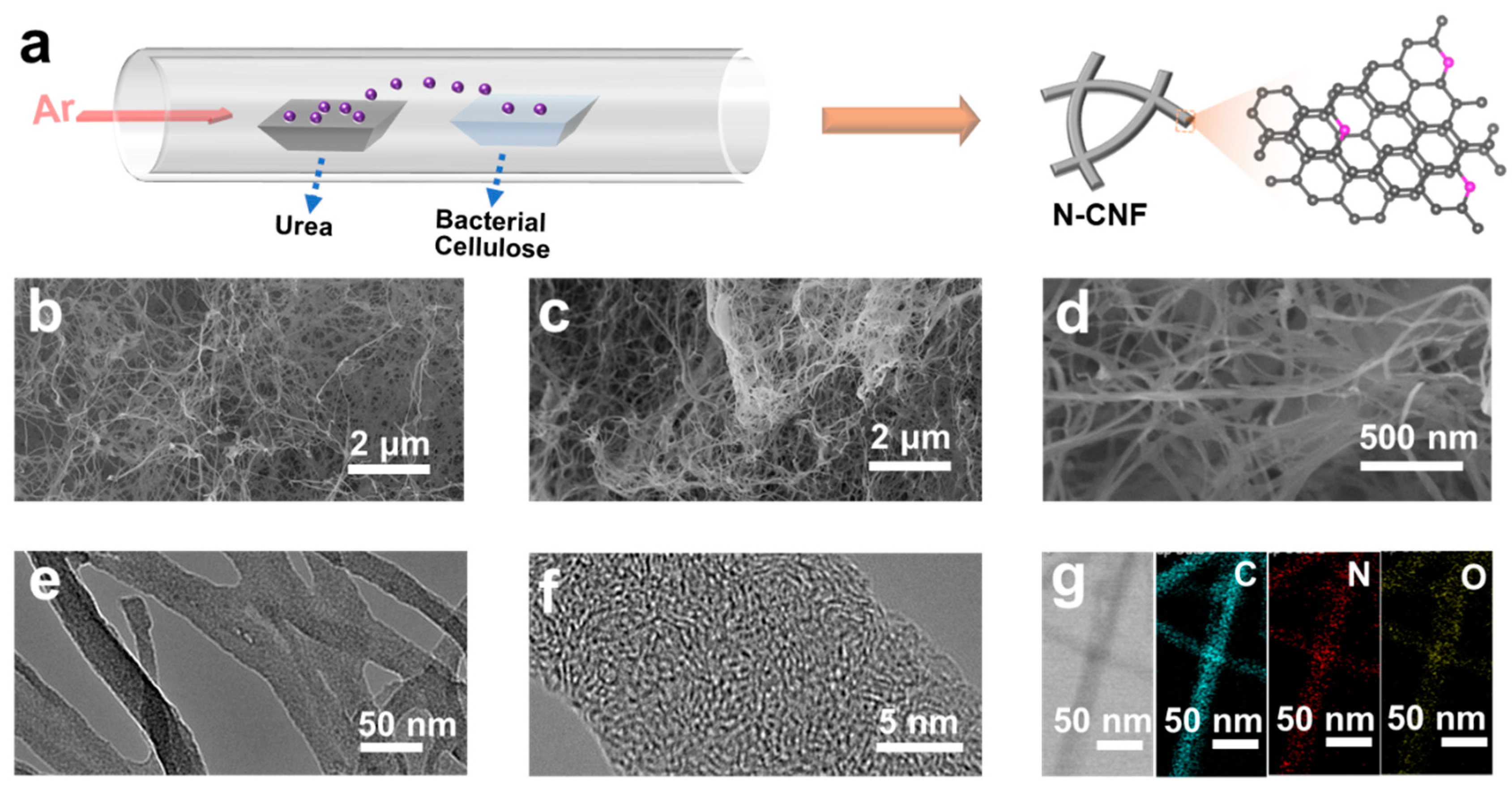
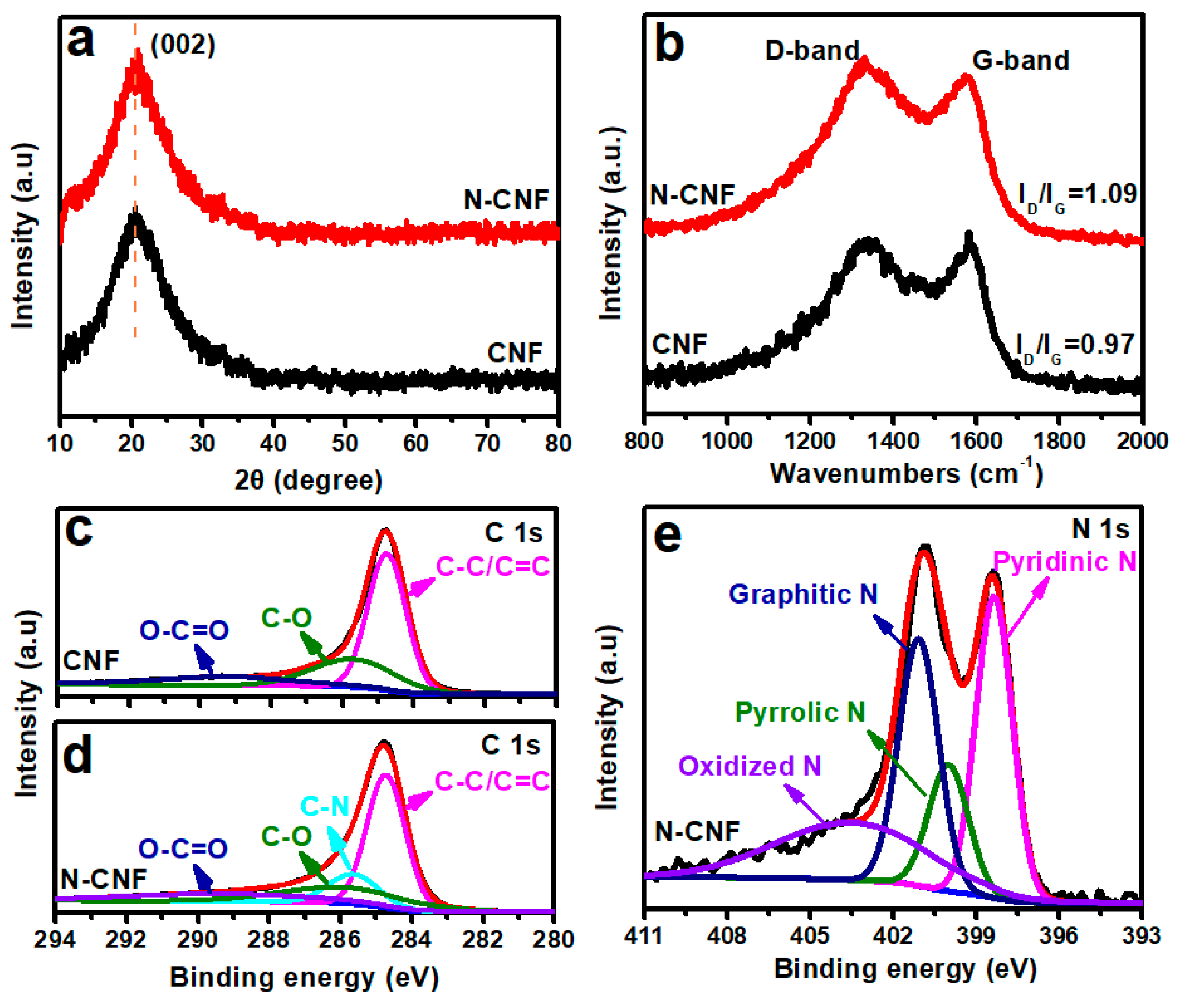

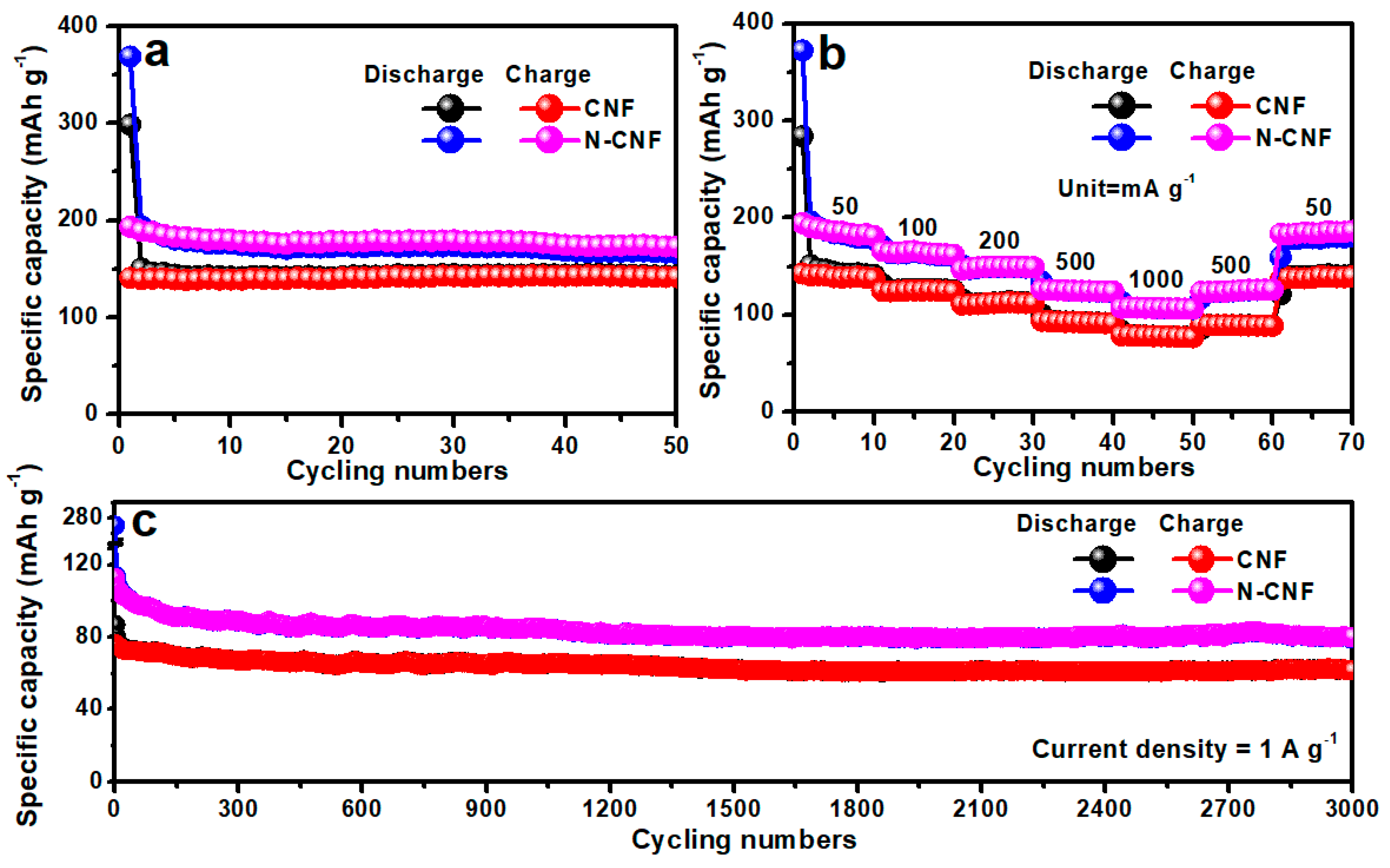
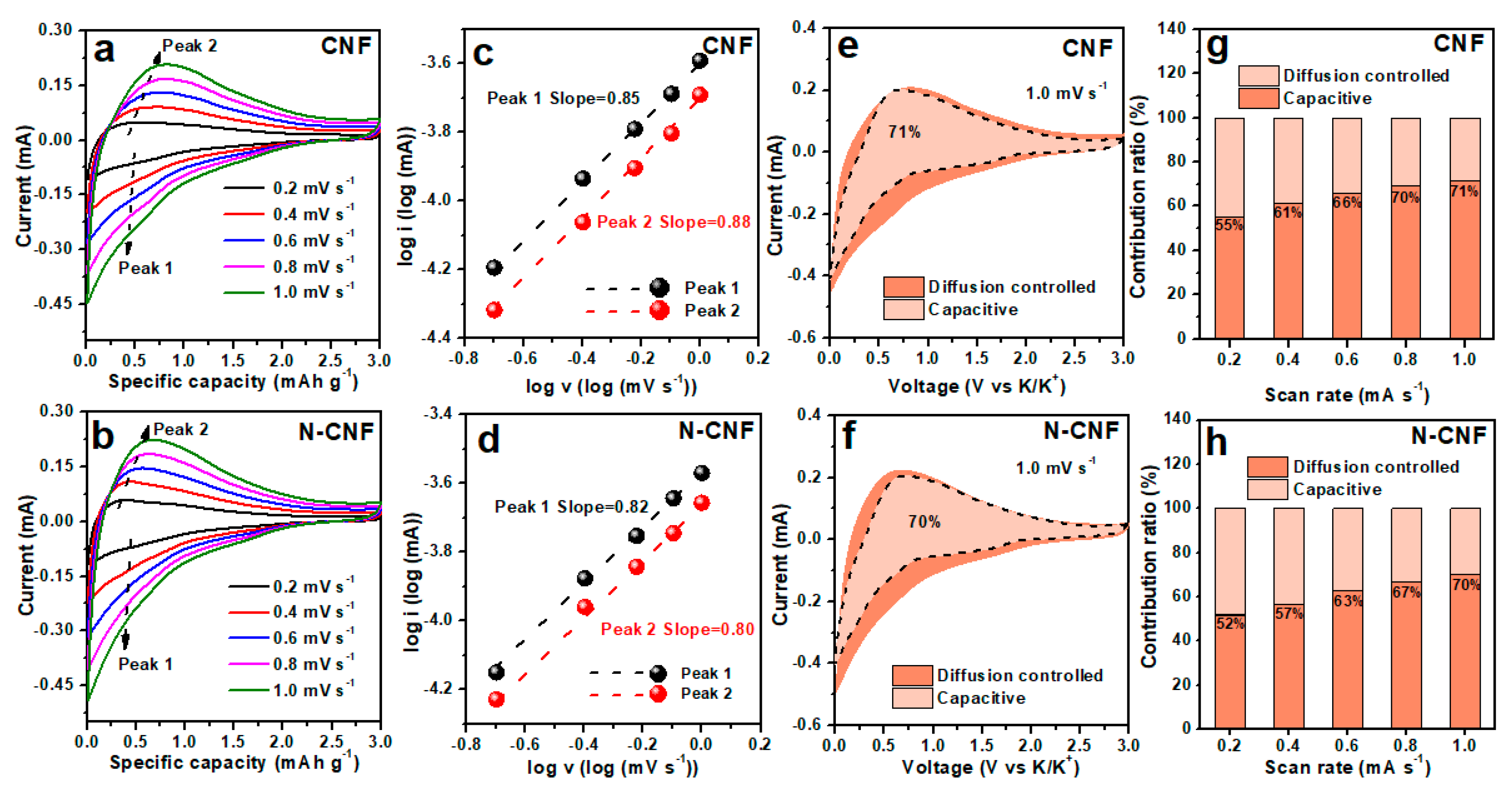
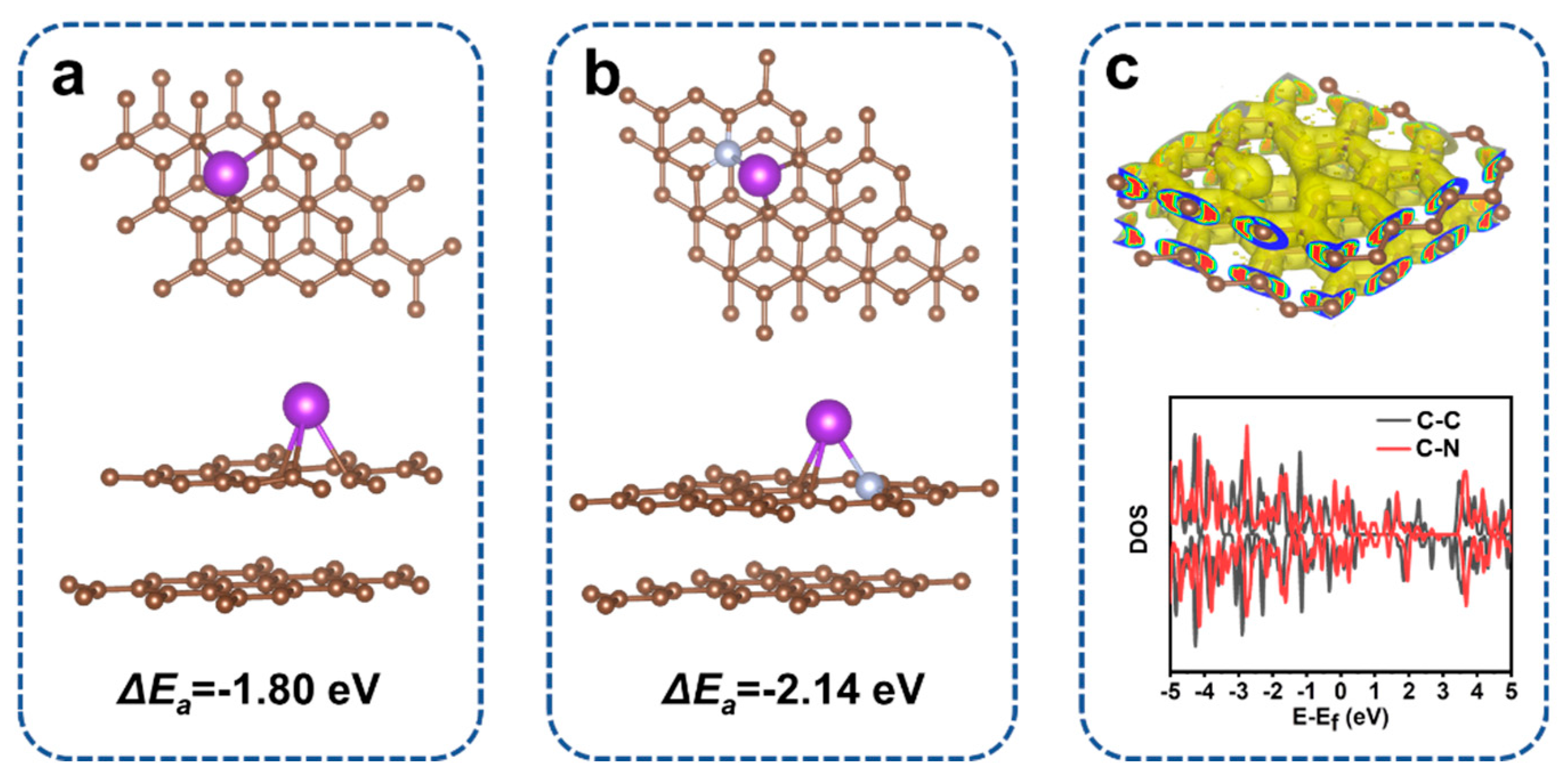
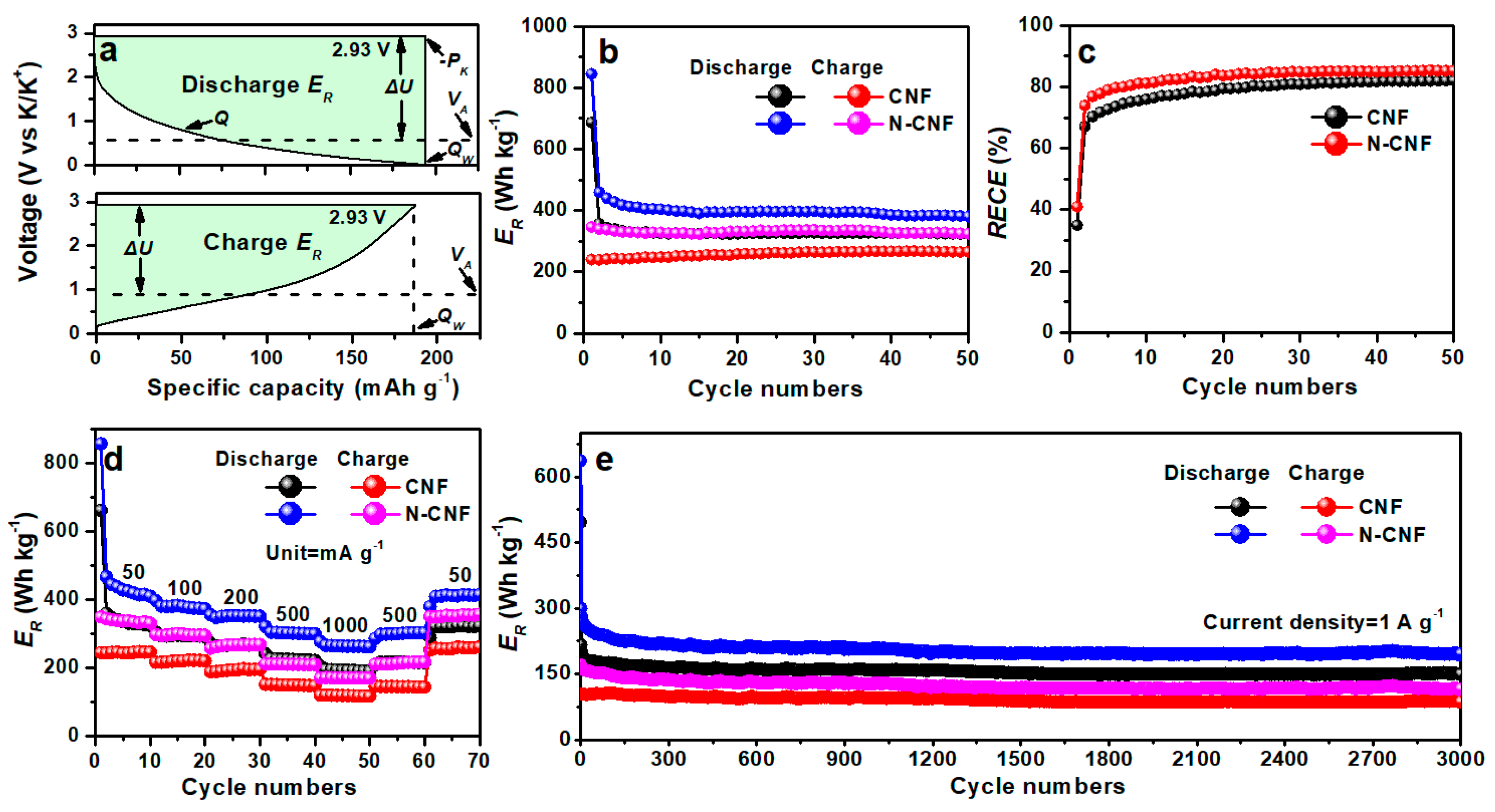
Publisher’s Note: MDPI stays neutral with regard to jurisdictional claims in published maps and institutional affiliations. |
© 2021 by the authors. Licensee MDPI, Basel, Switzerland. This article is an open access article distributed under the terms and conditions of the Creative Commons Attribution (CC BY) license (https://creativecommons.org/licenses/by/4.0/).
Share and Cite
Ma, L.; Li, J.; Li, Z.; Ji, Y.; Mai, W.; Wang, H. Ultra-Stable Potassium Ion Storage of Nitrogen-Doped Carbon Nanofiber Derived from Bacterial Cellulose. Nanomaterials 2021, 11, 1130. https://doi.org/10.3390/nano11051130
Ma L, Li J, Li Z, Ji Y, Mai W, Wang H. Ultra-Stable Potassium Ion Storage of Nitrogen-Doped Carbon Nanofiber Derived from Bacterial Cellulose. Nanomaterials. 2021; 11(5):1130. https://doi.org/10.3390/nano11051130
Chicago/Turabian StyleMa, Liang, Jinliang Li, Zhibin Li, Yingying Ji, Wenjie Mai, and Hao Wang. 2021. "Ultra-Stable Potassium Ion Storage of Nitrogen-Doped Carbon Nanofiber Derived from Bacterial Cellulose" Nanomaterials 11, no. 5: 1130. https://doi.org/10.3390/nano11051130
APA StyleMa, L., Li, J., Li, Z., Ji, Y., Mai, W., & Wang, H. (2021). Ultra-Stable Potassium Ion Storage of Nitrogen-Doped Carbon Nanofiber Derived from Bacterial Cellulose. Nanomaterials, 11(5), 1130. https://doi.org/10.3390/nano11051130








